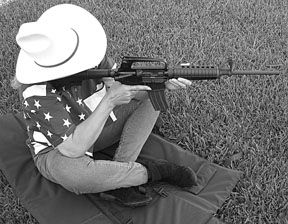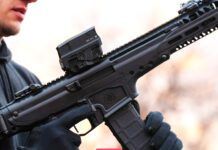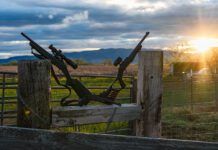
Last April a member of our staff traveled to Princeton, Louisiana, for two exhilarating days of instruction with five-time Soldier of Fortune champion Jim Clark Jr. (888-458-4126). The subject was not just long-range marksmanship and three-position fire with the AR-15 rifle, but also rapid engagement of multiple targets such as those found at a practical shooting match. The weapon of choice for such competition is the AR-15, the civilian descendant of the M16. A typical competition AR rifle carries a full stock and a 20- to 24-inch barrel. Another rifle built along the lines of the original Armalite M16 rifle is a shorter and lighter carbine currently in use by the military. The M4 and M4A1 series produced by Colt’s Manufacturing uses a collapsible polymer stock and 14.5-inch barrel weighing in at less than 6 pounds.
In this test we evaluated two weapons that are more closely related to the lightweight M4 carbines than the longer and heavier competition rifles. They were the DPMS Panther Arms RFA2-L16 rifle and the XM15-E2S from Bushmaster. Both of our test carbines sported 16-inch standard-contour barrels. They had fixed stocks, and both weighed in at less than 7 pounds. Despite their light weights and compact design, everything we learned from Jim Jr. still applied. Though it would seem reasonable to expect a drop off in accuracy from the bigger AR rifles, we hoped these carbines make up for it with increased versatility. Here’s what we found:
[PDFCAP(1)] Defense Procurement Manufacturing Service is what DPMS stands for, and at $699 the RFA2-L16 is one of the lowest-priced AR style weapons we’ve found. Two 10-round plastic magazines are supplied. Although they worked without malfunction and were easy to load, we think most customers may still prefer a metal carrier. (Based on superstition, maybe). The Panther’s 16 inch barrel is thin and light and this is likely one of the reasons why this model is sold for less money than a similar model from DPMS Panther that is fitted with a16 inch bull barrel. The Panther Bull Sweet Sixteen is listed at $885.00. But the additional weight of this model would spoil what we were looking for. We wanted a rugged, super-portable weapon, easy to maintain and operate with the potential for higher capacity, that offers fast target acquisition for rapid close-range fire plus long-range accuracy. Easier said than done? In fact, no. Our Panther RFA2-L16 weighed in at just 6.0 pounds. We liked its trigger very much. Overcoming its 6.5 pounds of resistance was so pleasant it reminded us of a good two-stage trigger. Handling this carbine at the bench was easy. The pistol grip is mounted at approximately the middle of the weapon lending exceptional balance. Actually, the positive handling aspects of the Panther are wholly shared with the Bushmaster model. Contributing design factors include the bulk of their weight being positioned so that it nearly surrounds the strong hand. The bolt is just above the hand and the ammunition is carried just in front of it. Remember, the stock is minimal in design resulting in little added weight. The barrels on these guns are also of bare essential design minimizing a muzzle heavy feel. Compare this to the monster revolvers we have tested in recent issues like the Magnum Research BFR revolvers. Our two test carbines were less clumsy to handle than any big revolver. Keep in mind that with the magazine release readily available to the right hand trigger finger and the safety handily placed for the thumb the sensation was more like that of handling a pistol than a rifle. Several times we found ourselves firing a couple of shots, pulling the carbine off the sandbag with finger out of the trigger guard and without putting it down checking hits with a pair of binoculars held in our left. Both the Bushmaster and Panther carbines were easy to handle, indeed.
While both the Panther and Bushmaster carbines are very much alike several differences became apparent. From the start we noticed that recoil from the Panther carbine moved the sights further off target and transmitted more shock to the shooter than the Bushmaster model. Taking a look at the bolt we saw that it was plated. We felt one possibility why this gun was moving more than its competitor was that the bolt was alloy instead of steel. But we checked with Panther Arms and we were informed that the bolt was steel but covered with hard chrome. Indeed, we measured the weight of the bolt in each carbine to be nearly the same. However the stock on the Panther is smaller and the plastic is of a different feel than the Bushmaster. This is likely a contributing factor. Each of our test models has a polymer stock that is non-collapsible. The butt plate on law enforcement and military models include a spring-loaded catch that allows the butt to slide forward on the tubular stock. Civilian models are pinned to maintain the overall length and discourage malicious concealment.
We found the nut that secures the stock on the Panther to be loose on several occasions leading us to believe that converting to a collapsible stock on this model would be easier than on the Bushmaster which was quite secure. Inside the stock is the traditional place for a cleaning kit and a very nice one is supplied. However, the stock is open without a cap to secure anything stored there. One nice touch is that the forward assist for the bolt is enlarged and serrated. One complaint was the operation of the magazine release.
A deft push of the release would drop the magazine and the button would return to its proper position. But, when pushed harder the button would stick and after the magazine dropped the catch was out of position to hold the next magazine. At the range we tested utilizing the supplied open sights for 50-yard shots. The DPMS Panther L16 (for short) did not come sighted in. Yes, windage was properly set but we had to reset the front sight quite a bit. Our Panther shot more than a foot low at fifty yards. Adjusting the sights (and nearly every other maintenance chore) on the AR rifles can be accomplished with one simple tool. That is, the point of a .223 bullet. But we did find adjusting the front sight to be quite tedious. One of the things we found out studying the subject with Jim Clark, Jr. was that a thinner than standard front post made fine accuracy easier to achieve.
[PDFCAP(2)]Also, with the wide front post it is possible under stress to mistake one of the protective “ears” found on either side of the front sight to be the sight blade itself. This happened to us several times during the intense drills that Jim put us through. We found thinning the front sight on our target AR-15 to approximately 0.040 helped us fire more accurately at distance and to our surprise we also gained faster sight acquisition. The Panther’s front post measured approximately .075 inches. At 50 yards from a sandbag rest our best groups were achieved firing the 77-grain Black Hills hollowpoint. Best group measured 1.4 inches for an average of 1.6 inches for 5 5-shot groups. However, we did experience stoppages with this round in both guns. We could attribute this to any one of three factors. First of all the overall length of these rounds was longer than when compared to the more reliable 55-grain ammunition. (The 55-grain bullet is generally recommended for use in AR-15 style weapons due mostly to 1 in 9 inch barrel twist rates but reliable feeding is also a factor.) The 55-grain rounds we fired measured just over 1.22 inches long. The 77-grain rounds were well over 1.24 inches in length. This didn’t leave much room in the magazine and with the lighter overall weight of the gun the magazine is moving back and forth faster under recoil and recovery. The heavier bullet may stay put longer and shift out of position due to the increased inertia. We’ve seen an exaggeration of this in the Titanium revolvers where the recoil can actually pull the bullet from its case.
Additionally the hollowpoint tip would likely produce some resistance against the inside of the magazine or entering the chamber. However, the 55-grain ammunition from Georgia Arms ran a close second with an average size 5-shot group of 1.8 inches. Another reason why this carbine is substantially less expensive than the Bushmaster is that adjustment at the rear sight is for windage only. Shots at 50 yards were fired utilizing the smaller of the two rear peep sights.
Actually we did not find that much difference in definition from one aperture to the other on the Panther. We noticed that the larger aperture appears to be bigger than it is because the rear face is beveled out but the actual hole you look through is nearly as small as the peep intended for longer range shooting. Getting the head down and firing at multiple targets at closer range requires that additional peripheral vision be available through the sights.
One solution is to enlarge this aperture. Another is to add a rapid acquisition electronic “dot” scope. This type of scope projects a red dot on to its lens that corresponds to point of impact. The advantage is that the shooter can maintain focus downrange at the target and not waste time making any further comparison or alignment. We chose the C-More Railway scope (888-265-8266), which typically sells for around $240. Our past experience with C-More scopes is extensive. One of our staff members has a C-More that has been in continuous service since 1996. It has sat atop a hybrid ported .357 revolver and a 12-gauge shotgun. This same scope currently rides on a .38 Super Open IPSC pistol that just finished second in the 2003 Lone Star Championship.
So, we know the C-More is dependable. Being carry handle models the scope mounted high. This meant rapid target acquisition from a heads up display. With the scope in place we continued accuracy tests from 100 yards seated behind a sandbag rest. At double the distance firing both of the Black Hills rounds group size shrank by nearly one-quarter inch. Actually, for this application a smaller dot would have been more helpful. Indeed, the C-More is of modular design and extra reticles as small as 2 MOA are available. But, we just went with the 8 MOA we had been shooting with and still produced accuracy at 100 yards of less than 1.5 inches. Additionally, our speed in multiple target drills at every distance was vastly improved. While a couple of features are in need of further attention the model RFA2-L16 from DPMS Panther Arms is still a good buy.
[PDFCAP(3)] We can’t really say where the Bushmaster product picks up all of the extra 8 ounces it carries compared to the Panther Arms model but several factors obviously contribute to the difference in price. While this model came with only one magazine it was steel bodied rather than plastic as in the case of the Panther model. The barrel is marginally thicker. The difference of outside diameter is just enough to be noticeable to the naked eye (about 0.07 inches).
Taking it from the top, the sights are much better. The finish and profile of the front post is easier to see. The rear sight is adjustable for windage and elevation. Also, the knobs can be turned by hand without them being so loose or vulnerable that adjustment can be lost by incidental contact.
Both our test guns came with sling attachments and a short ventilated fore end. The Bushmaster comes in a foam-padded plastic rifle case, while the Panther arrives in a cardboard box. As mentioned before the butt stock is more substantial and we feel it mates better with the typical shoulder or pectoral area. The release for the telescopic stock is secured in such a manner that substantial modification would have to take place to violate the law. The two flip up peep sights are substantially different.
The smaller aperture is in our opinion just right for longer-range fire. Perhaps more importantly for a lightweight carbine the larger aperture is much more open. It genuinely affords the shooter extra peripheral vision but there is still enough focus for accurate shots. Even a member of our staff whose vision is cross dominant and sometimes has difficulty closing the left eye was able to pick up the sights quickly. The slightly longer length of pull also helps locate the eye in relation to the sights. We measured the Bushmaster trigger to be heavier than the Panther’s by two pounds. While the feel of the Panther’s trigger alluded to a two stage design (both weapons use single stage triggers) the Bushmaster asked that we take up slack and then push against a solid resistance to break a shot.
Length of pull between the two guns was nearly the same but we measured a 1.6-inch difference in overall length. Much of the Bushmaster’s additional length was attributed to the stock. If this extra length was in fact turning the XM15-E2S into a longer lever than perhaps this is one answer why we found this carbine to be more stable during fire than the Panther. In terms of breaking the guns down we felt each of them was very close in handling and fit. But in terms of controls we had an easier time knocking off the Bushmaster’s safety without help from the weak hand. Also, the Bushmaster’s magazine release worked flawlessly.
At the 50-yard range the Bushmaster shot groups that consistently measured an average of 1.5 inches center to center or less with open sights. This carbine was very easy to sight in and held its zero. We tried changing the elevation and windage adjustments at the rear sights but so long as we kept track of how many clicks we made in each direction the original point of impact could be recalled without fear of drift.
The tightest group of the test at 50 yards with supplied sights came firing the Georgia Arms 55-grain FMJ round. Best group measured 0.80 inches. The best group at 100 yards using the C-more scope measured 1.4 inches firing the heavier Black Hills Ammunition 77-grain round. One reason we like the Bushmaster better is that it does not physically punish the shooter as much as we would expect from such a light rifle. In our opinion the XM15-E2 carbine has a big gun feel to it. We even went ahead and tried accessories such as double magazine clamps for faster reloads.
Regardless of whether or not magazine capacity restrictions are lifted in the future there are still plenty of 20- or 30-shot pre-ban magazines around that can be legally purchased.
Gun Tests Recommends
DPMS Panther Arms RFA2-L16 .223 Remington, $699. Best Buy. This gun has a few small problems that are easily solved. At a price that is less than many handguns, we think this is a bargain in self-defense.
Bushmaster XM15-E2S .223 Remington Carbine, $975. Our Pick. We think this is one of the most shooter-friendly weapons we’ve fired. With its big-gun feel, the type of recoil that might make people shy away from a light rifle simply doesn’t exist here. Fast, accurate, reliable (and fun), we think this carbine is worth every penny.


























